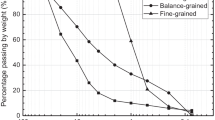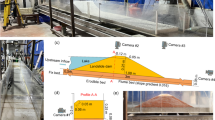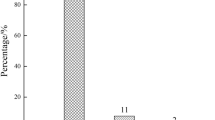Abstract
Affected by earthquakes and heavy rainfall, multiple landslide dams often cluster closely together along river reaches or gullies. Compared with a single landslide dam, the burst flood produced by the cascading failure of multiple landslide dams can be enhanced, seriously threatening life and property downstream. Here, we conduct a series of experiments in a 42 m flume to investigate the failure mechanisms of single and paired dams with fine-grained, well-graded, and coarse-grained debris; analyze the effects of dam geometry and initial water level of a downstream dam on the cascading breach; and quantitatively evaluate the amplification effect of cascading breach discharge. Single dams fail by overtopping along with seepage instability for a fine-grained dam, headcutting for a well-graded dam, and overtopping for a coarse-grained dam, respectively. The type of failure which occurs for a single dam is influenced by the shear strength of the dam material and seepage. However, the downstream dams in cascading tests fail by overtopping irrespective of dam material due to the large outburst floods from the upstream dams. A general flat slope angle is maintained during breaching for the fine-grained and coarse-grained dams, while a step-pool structure is developed for the well-graded dams because the finer grains are easier to wash away than coarse grains. The peak breach discharge for a downstream dam is 1.4–1.9 times the value for an upstream dam in the experimental runs, indicating the amplification effect of breach discharge. The amplification effect has a negative linear correlation with the time interval between the peak breach discharges of the two dams because the overlap of breach processes of upstream and downstream dams is gradually reduced as the time interval increases.















Similar content being viewed by others
Abbreviations
- A f :
-
Amplification factor of the peak discharge
- A l :
-
Surface area of lake water
- C :
-
Cohesion of dam material
- C c :
-
Curvature coefficient of the grading curve
- C u :
-
Uniformity coefficient of the grading curve
- d 50 :
-
Median grain size of a dam material
- d h :
-
Height of a downstream dam
- d w :
-
Crest width of a downstream dam
- f s :
-
Seepage stress
- F s :
-
Sliding stress generated by gravity
- g :
-
Gravitational acceleration
- h :
-
Slide thickness
- h r :
-
The maximum residual dam height
- H t :
-
Upstream water level
- H ti :
-
Water level at each of the four measuring points
- h w :
-
Initial difference of impounded water level between the upstream and downstream dam
- i :
-
Hydraulic gradient
- k :
-
Saturated permeability coefficient of dam material
- q b :
-
Breach discharge of a dam
- q d :
-
Peak discharge of a downstream dam
- q in :
-
Inflow rate to the reservoir upstream of a dam
- q s :
-
Seepage discharge through a dam
- q u :
-
Peak discharge of an upstream dam
- R s :
-
Resistance stress
- s :
-
Stability coefficient of a downstream dam slope
- t bo :
-
Time from the breach of an upstream dam to overflow of a downstream dam
- t int :
-
Time interval between peak breach discharges of the two dams
- α :
-
Angle of downstream dam slope
- θ :
-
Slope angle of a residual dam
- ρ d :
-
Dry density of a dam material
- ρ w :
-
Water density
- σ :
-
Effective normal stress
- φ :
-
Internal friction angle of a dam material
References
Awal R, Nakagawa H, Kawaike K, Baba Y, Zhang H (2008) Prediction of flood/debris flow hydrograph due to landslide dam failure by overtopping and sliding. Annuals Disaster Prev Res Ins, Kyoto University 51(B):603–611
Briaud J (2008) Case histories in soil and rock erosion: Woodrow Wilson Bridge, Brazos River Meander, Normandy Cliffs, and New Orleans Levees. J Geotech Geoenviron Eng 134(10):1425–1447
Cao Z, Yue Z, Pender G (2011) Flood hydraulics due to cascade landslide dam failure. J Flood Risk Manag 4(2):104–114
Chang DS, Zhang LM (2010) Simulation of the erosion process of landslide dams due to overtopping considering variations in soil erodibility along depth. Nat Hazards Earth Syst Sci 10(4):933–946
Chang DS, Zhang LM, Xu Y, Huang RQ (2011) Field testing of erodibility of two landslide dams triggered by the 12 May Wenchuan earthquake. Landslides 8:321–332
Chen CY, Chang JM (2016) Landslide dam formation susceptibility analysis based on geomorphic features. Landslides 13(5):1019–1033
Chen S, Chen Z, Tao R, Yu S, Xu W, Zhou X, Zhou Z (2018) Emergency response and back analysis of the failures of earthquake triggered cascade landslide dams on the Mianyuan River. China Nat Hazards Rev 19(3):05018005
Chen SC, Lin TW, Chen CY (2015) Modeling of natural dam failure modes and downstream riverbed morphological changes with different dam materials in a flume test. Eng Geol 188:148–158
Clague J, Evans G (1994) Formation and failure of natural dams in the Canadian Cordillera. Geol Surv Can Bull 464
Coleman SE, Andrews DP, Webby MG (2002) Overtopping breaching of noncohesive homogeneous embankments. J Hydraul Eng 128(9):829–838
Costa JE, Schuster RL (1988) The formation and failure of natural dams. Geol Soc Am Bull 100(7):1054–1068
Cui P, Zhou GGD, Zhu XH, Zhang JQ (2013) Scale amplification of natural debris flows caused by cascading landslide dam failures. Geomorphology 182:173–189
Davies T, Manville V, Kunz M, Donadini L (2007) Modeling landslide dambreak flood magnitudes: Case study. J Hydraul Eng 133(7):713–720
Dong JJ, Li YS, Kuo CY, Sung RT, Li MH, Lee CT, Chen CC, Lee WR (2011) The formation and breach of a short-lived landslide dam at Hsiaolin village, Taiwan-part I: Post-event reconstruction of dam geometry. Eng Geol 123(1):40–59
Fan X, Westen CJV, Xu Q, Gorum T, Dai FC (2012) Analysis of landslide dams induced by the 2008 Wenchuan earthquake. J Asian Earth Sci 57(6):25–37
Gong WP, Juang CH, Wasowski J (2021) Geohazards and human settlements: lessons learned from multiple relocation events in Badong, China–Engineering geologist's perspective. Eng Geol 285:106051
Gregoretti C, Maltauro A, Lanzoni S (2010) Laboratory Experiments on the Failure of Coarse Homogeneous Sediment Natural Dams on a Sloping Bed. J Hydraul Eng 136(11):868–879
Fritz HM, Hager WH, Minor HE (2004) Near field characteristics of landslide generated impulse waves. J Waterw Port Coast Ocean Eng 130(6):287–302
Hancox GT, Mc T, Saveney MJ, Manville V, Davies T (2005) The October 1999 Mt Adams rock avalanche and subsequent landslide dam-break floods and effects in Pourea River, Westland, New Zealand. N.Z. J Geol Geophys 48:683–705
Huang R, Fan X (2013) The landslide story. Nat Geosci 6(5):325
Iverson RM, Logan M, LaHusen RG, Berti M (2010) The perfect debris flow? Aggregated results from 28 large-scale experiments. J Geophys Res 115:F03005
Jiang X, Huang J, Wei Y, Niu Z, Chen F, Zou Z, Zhu Z (2018) The influence of materials on the breaching process of natural dams. Landslides 15(2):243–255
Korup O (2004) Geomorphometric characteristics of New Zealand landslide dams. Eng Geol 73:13–35
Korup O (2005) Geomorphic imprint of landslides on alpine river systems, southwest New Zealand. Earth Surf Process Landf 30(7):783–800
Liao HW, Lee CT (2000) Landslides triggered by the Chi-Chi earthquake. Proceedings of the 21st Asian conference on remote sensing, 383–388
Niu Z, Xu W, Li N, Xue Y (2012) Experimental investigation of the failure of cascade landslide dams. J Hydrody 24(3):430–441
Peng M, Jiang Q, Zhang Q, Hong Y, Jiang M, Shi Z, Zhang L (2019). Stability analysis of landslide dams under surge action based on large-scale flume experiments. Eng Geol 259:105191
Peng M, Ma CY, Chen HX, Zhang P, Zhang LM, Jiang MZ, Zhang QZ, Shi ZM (2021). Experimental study on breaching mechanisms of landslide dams composed of different materials under surge waves. Eng Geol 291:106242
Peng M, Zhang LM (2012) Breaching parameters of landslide dams. Landslides 9(1):13–31
Peng M, Zhang LM, Chang DS, Shi ZM (2014) Engineering risk mitigation measures for the landslide dams induced by the 2008 Wenchuan earthquake. Eng Geol 180:68–84
Powledge GR, Ralston DC, Miller P, Chen YH, Clopper PE, Temple DM (1989) Mechanics of overflow erosion on embankments. II: hydraulic and design considerations. J Hydraul Eng 115 (8):1056–1075
Risley JC, Walder JS, Denlinger RP (2006) Usoi Dam wave overtopping and flood routing in the Bartang and Panj Rivers. Tajikistan Nat Hazards 38(3):375–390
Schmocker L, Hager WH (2009) Modelling dike breaching due to overtopping. J Hydraul Res 47(5):585–597
Semenza E, Ghirotti M (2000) History of the 1963 Vaiont slide: the importance of geological factors. Bull Eng Geol Environ 59(2):87–97
Shan Y, Chen S, Zhong Q (2020) Rapid prediction of landslide dam stability using the logistic regression method. Landslides 17:2931–2956
Shen DY, Shi ZM, Peng M, Zhang LM, Jiang MZ (2020) Longevity analysis of landslide dams. Landslides 17(8):1797–1821
Shi ZM, Guan SG, Peng M, Zhang LM, Zhu Y, Cai QP (2015) Cascading breaching of the Tangjiashan landslide dam and two smaller downstream landslide dams. Eng Geol 193:445–458
Shi Z, Zheng H, Yu S, Peng M, Jiang T (2018) Application of CFD-DEM to investigate seepage characteristics of landslide dam materials. Comput Geotech 101:23–33
Strom A (2010) Landslide dams in Central Asia region. Journal of the Japan Landslide Society 47(6):309–324
Takahashi T (2007) Debris flows: Mechanics, prediction and countermeasures. Taylor and Francis, London/Balkema, Leiden, The Netherlands
Walder JS, Iverson RM, Godt JW, Logan M, Solovitz SA (2015) Controls on the breach geometry and flood hydrograph during overtopping of noncohesive earthen dams. Water Resour Res 51(8):6701–6724
Wang HB, Sassa K, Xu WY (2007) Analysis of a spatial distribution of landslides triggered by the 2004 Chuetsu earthquakes of Niigata Prefecture. Japan Nat Hazards 41(1):43
Wang Z, Melching CS, Duan X, Yu G (2009) Ecological and hydraulic studies of step-pool systems. J Hydraul Eng 135(9):705–717
Wang Z, Cui P, Yu G, Zhang K (2012) Stability of landslide dams and development of knickpoints. Environ Earth Sci 65(4):1067–1080
Xu FG, Yang XG, Zhou JW (2015) Experimental study of the impact factors of natural dam failure introduced by a landslide surge. Environ Earth Sci 74(5):4075–4087
Zhao H, Zhang L, Xu Y (2013) Variability of geotechnical properties of a fresh landslide soil deposit. Eng Geol 166(8):1–10
Zheng H, Shi Z, Peng M, Yu S (2018) Coupled CFD-DEM model for the direct numerical simulation of sediment bed erosion by viscous shear flow. Eng Geol 245:309–321
Zheng H, Shi Z, Shen D, Peng M, Hanley KJ, Ma C, Zhang L (2021) Recent advances in stability and failure mechanisms of landslide dams. Front. Earth Sci 9:659935
Zhou GGD, Cui P, Chen HY, Zhu XH, Tang JB, Sun QC (2013) Experimental study on cascading landslide dam failures by upstream flows. Landslides 10(5):633–643
Zhou GGD, Zhou M, Shrestha MS, Song D, Choi CE, Cui K, Peng M, Shi Z, Zhu X, Chen H (2019) Experimental investigation on the longitudinal evolution of landslide dam breaching and outburst floods. Geomorphology 334:29–43
Acknowledgements
We acknowledge funding from the Natural Science Foundation of China (No. 41731283, 41877234, 42007252, and 42061160480). Constructive reviews by the editor and two anonymous reviewers helped to improve the manuscript and are gratefully acknowledged.
Author information
Authors and Affiliations
Corresponding authors
Supplementary Information
Below is the link to the electronic supplementary material.
Rights and permissions
About this article
Cite this article
Zheng, H., Shi, Z., Peng, M. et al. Amplification effect of cascading breach discharge of landslide dams. Landslides 19, 573–587 (2022). https://doi.org/10.1007/s10346-021-01816-0
Received:
Accepted:
Published:
Issue Date:
DOI: https://doi.org/10.1007/s10346-021-01816-0




